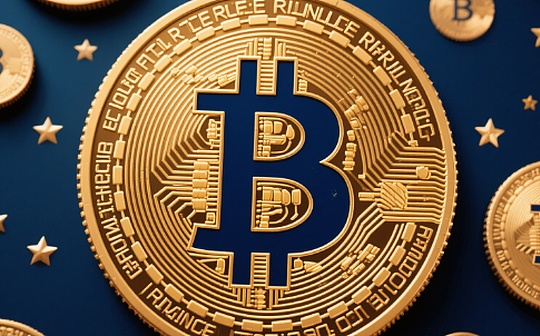
author:fejau, encryption researcher; compiled by: AIMan@Bitchain Vision
I want to write a question I have been thinking about: How will Bitcoin perform when it experiences an unprecedented major change in the capital flow pattern?I think once “decentralization” is over, it will usher in an incredible deal.In this article, I will break down my thoughts.Let’s start.
Historically, what are the main drivers of Bitcoin’s price?
I will take Michael Howell’s research on the historical drivers of Bitcoin’s price movements and then use these studies to further understand how these cross-trends will evolve in the near future.
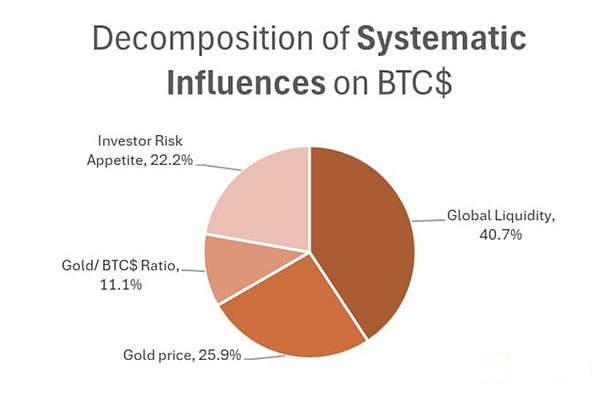 As shown in the above image, the drivers of BTC include:
As shown in the above image, the drivers of BTC include:
-
Investors are generally interested in high-risk, high-beta assets
-
Relevance to gold
-
Global liquidity
The simple framework I have developed since 2021 to understand risk appetite, gold performance and global liquidity is,Focus on fiscal deficit as a percentage of GDP, it has been a fiscal impulse for the global market dominant force since 2021.
The higher the fiscal deficit in GDP, the higher the inflation and nominal GDP will inevitably lead to an increase in corporate revenue, because revenue is a nominal indicator.For companies that can enjoy the benefits of economies of scale, this is undoubtedly conducive to their profit growth.
In most cases, monetary policy is under fiscal stimulus, which is the main driving force for risk asset activity.As shown in this chart regularly updated by @BickerinBrattle, the monetary stimulus in the United States is very downturn relative to fiscal stimulus, so I will put it aside in this discussion.
 As we see in the following figure, the major developed Western economiesThe U.S. fiscal deficit represents a much higher percentage of GDP than any other country.
As we see in the following figure, the major developed Western economiesThe U.S. fiscal deficit represents a much higher percentage of GDP than any other country.
 With such a large deficit in the United States, revenue growth has been dominant and has led to U.S. stock markets perform well compared to other modern economies:
With such a large deficit in the United States, revenue growth has been dominant and has led to U.S. stock markets perform well compared to other modern economies:
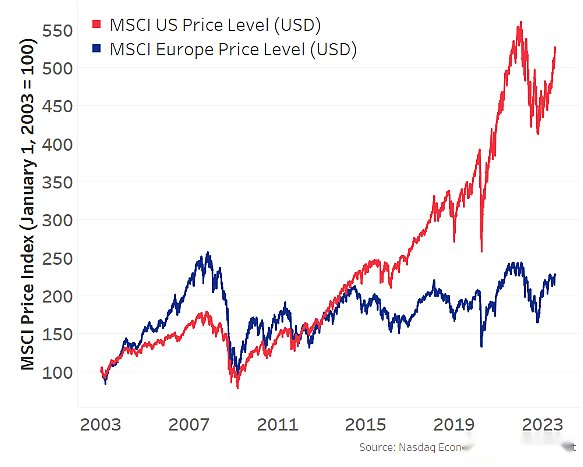 Due to this dynamic,U.S. stock market has been the main marginal driver of risk asset growth, wealth effects and global liquidity, therefore, global capital flows to the most favorable place: the United States.As this dynamic of capital inflow into the United States, coupled with a huge trade deficit, the United States acquires goods while foreign countries acquire dollars, which then reinvest in U.S. dollar denominated assets such as U.S. Treasury bonds and MAG7, the United States has become the main driver of all global risk appetite:
Due to this dynamic,U.S. stock market has been the main marginal driver of risk asset growth, wealth effects and global liquidity, therefore, global capital flows to the most favorable place: the United States.As this dynamic of capital inflow into the United States, coupled with a huge trade deficit, the United States acquires goods while foreign countries acquire dollars, which then reinvest in U.S. dollar denominated assets such as U.S. Treasury bonds and MAG7, the United States has become the main driver of all global risk appetite:
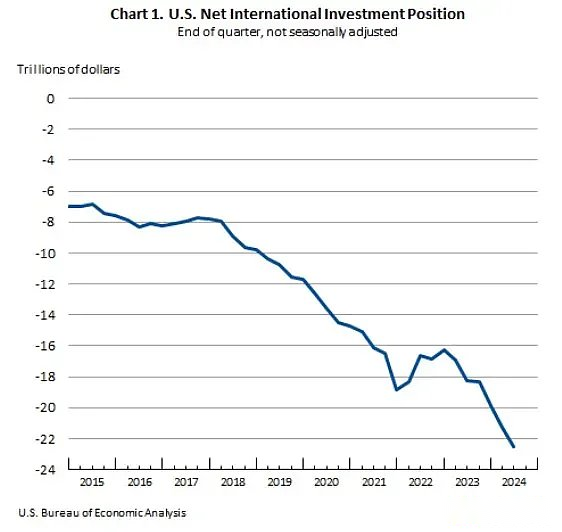
Now, back to Michael Howell’s research above.Risk preference and global liquidity have been driven primarily by the United States for a decade, and since the US fiscal deficit far exceeds that of other countries, this trend has further accelerated since the outbreak of the new crown epidemic.
Because of this, although Bitcoin is a global liquid asset (not just the United States), it has a positive correlation with U.S. stock markets and has become increasingly close since 2021:
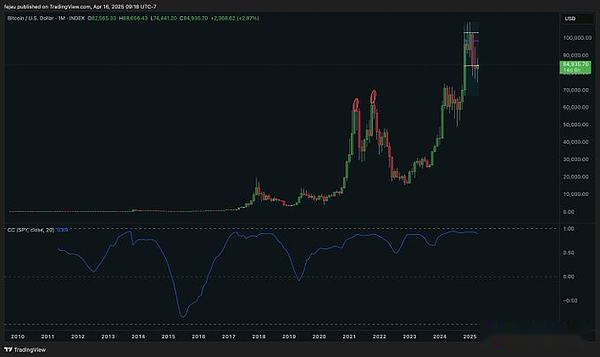
Causal relationship between global liquidity and Bitcoin
Now,I think the correlation between Bitcoin and the U.S. stock market is false.I use the term “false correlation” here, in a statistical sense, because I think the third causal variable is not shown in the correlation analysis, and that is the real driver.I think this is global liquidity, as we mentioned above, global liquidity has been dominated by the United States for nearly a decade.
When we dig into statistical significance, we must also establish causality, not just positive correlations.Fortunately, Michael Howell also did a great job through the Granger causality test,Establishing the causal relationship between global liquidity and Bitcoin:
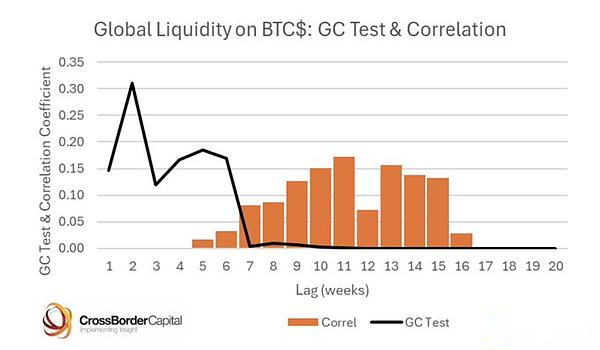 What reference value does this have to us?
What reference value does this have to us?
Bitcoin is mainly driven by global liquidity, and a false correlation emerges as the United States has been the main driver of global liquidity increase.
What does the Trump tariff war mean?
Some mainstream views have emerged over the past month as we are all speculating on Trump’s trade policy and the goal of global capital and commodity flow restructuring.I think these views are as follows:
-
The Trump administration hopes to reduce its trade deficit with other countries, which inevitably means a decrease in the dollar flowing to foreign countries and will no longer invest in U.S. assets.Without this, the trade deficit would not have been reduced.
-
The Trump administration believes that foreign currencies have been artificially suppressed, resulting in the artificially strong pulling up the dollar and hopes to rebalance the situation.In short, a weaker dollar and stronger foreign currencies will lead to higher interest rates in other countries, resulting in capital returning to the domestic market to obtain better-performing interest rates after foreign exchange adjustments, as well as domestic stock markets.
-
Trump’s preemptive approach in trade negotiations is pushing other countries around the world to get rid of (as mentioned above) a meager fiscal deficit relative to the United States and instead invest in defense, infrastructure, and generally protectionist government investments to improve their ability to be self-sufficient.Regardless of whether the tariff negotiations eventually cool down (except China), I believe that demons have emerged from the bottle and countries will continue to pursue this pursuit.
-
Trump hopes other countries increase their share of defense spending as a percentage of GDP and increase their contribution to NATO, as the United States already bears most of NATO’s costs.This will also exacerbate the fiscal deficit.
I will put aside my personal opinion of these ideas, because there are already many of them, and I am just focusing on what they might mean if we understand them according to the logic of these narratives:
-
Capital will leave US dollar-denominated assets and return to other countries.This means that U.S. stock markets perform poorly compared to the rest of the world, bond yields rise and the dollar depreciates.
-
These capital is flowing to places where fiscal deficits are no longer restricted, and other modern economies will start to consume and print money to make up for these increased deficits.
-
As the United States continues to move from global capital partners to more protectionist partners, dollar asset holders will have to increase the risk premium of these previously pure assets and must set a higher margin of security.This situation will lead to higher bond yields and prompt foreign central banks to seek diversified balance sheets, shifting from pure U.S. Treasury bonds to other neutral commodities such as gold.Similarly, foreign sovereign wealth funds and pension funds may pursue this asset diversification.
-
The contrary view is that the United States is the center of innovation and technology-driven growth, and no country can replace this position.Europe is too bureaucratic and socialist to pursue capitalism like the United States.I agree with this view, which may cause this trend not to last for many years and is more like a medium-term trend, as the valuation of these tech stocks will limit their upside potential for a period of time.
Back to the title of this article,The first transaction that appeared was the sell-off of the generally held US dollar assets and the ongoing reduction of holdings..Such a reduction could become confusing due to widespread holdings of these assets worldwide, as large fund managers and more speculative investors, such as multi-strategy hedge funds with strict stop loss, hit the risk limit.When this happens, we encounter margin days, and all assets need to be sold to raise cash.Currently, the goal of the transaction is to survive this process and eventually obtain enough funds.
However,As this reduction settles, the next transaction begins – a diversified portfolio, including foreign stocks, foreign bonds, gold, commodities, and even Bitcoin.
On rotation market day and non-margin day,We are beginning to see this dynamic gradually take shape.The U.S. stock markets are down, with gold soaring, while Bitcoin is surprisingly better than traditional U.S. technology stocks.
I believe that as this happens, the marginal growth of global liquidity will transform into a completely opposite dynamic that we are accustomed to.The rest of the world will assume the responsibility of increasing global liquidity and thus increase risk appetite.
As I ponder the risks of such diversified investments in the context of a global trade war, I worry that over-investment in risky assets in other countries will bring tail risks, as these assets may face some significant risks, such as unpleasant tariff news that may affect these assets.therefore,In this transition, I think gold and Bitcoin are ideal for global diversified investment.
Gold has been at an absolute strength and is setting new highs every day, reflecting the change in this pattern.However, although Bitcoin has shown unexpectedly good performance throughout the transition of the landscape, its correlation with risk appetite has been suppressed so far and has failed to keep up with the excellent performance of gold.
So, as we move towards a global capital rebalancing, I believe the next transaction will be Bitcoin.
Bitcoin may be decoupled from U.S. tech stocks
When I compare this framework with Howell’s relevance work, I can see their connection points:
-
The U.S. stock market will not be affected by global liquidity, but will only be affected by liquidity measured by fiscal stimulus measures and some capital inflows (but we just confirmed that this part of the flow may stop or even reverse).However, Bitcoin is a global asset that reflects this broad perspective of global liquidity.
-
As this statement becomes more entrenched and risk configurators continue to rebalance, I believe risk preferences will be driven by the rest of the world rather than the United States.
-
Gold may perform similarly to Bitcoin, because the BTC driving force is also related to gold.
All these factors have been established, since I observed the financial market,See the possibility of Bitcoin decoupling from US tech stocks for the first time.I know, this sounds like a “widow maker” and usually marks a partial peak in Bitcoin.The difference is that this time we are seeing the possibility of significant changes in capital flows, which will keep it going.
So for me, a risk-seeking macro trader, Bitcoin seems to be the cleanest transaction besides tariff transactions here.You can’t impose tariffs on Bitcoin, it doesn’t care which country it is located, it provides a high beta coefficient for the portfolio, without the tail risks currently associated with U.S. technology, I don’t need to take any view of the EU’s rectification, it also provides a clean global liquidity exposure, not just U.S. liquidity.
Bitcoin is born for this market mechanism.Once the dust settles, it will become the fastest steed.Speed up.








